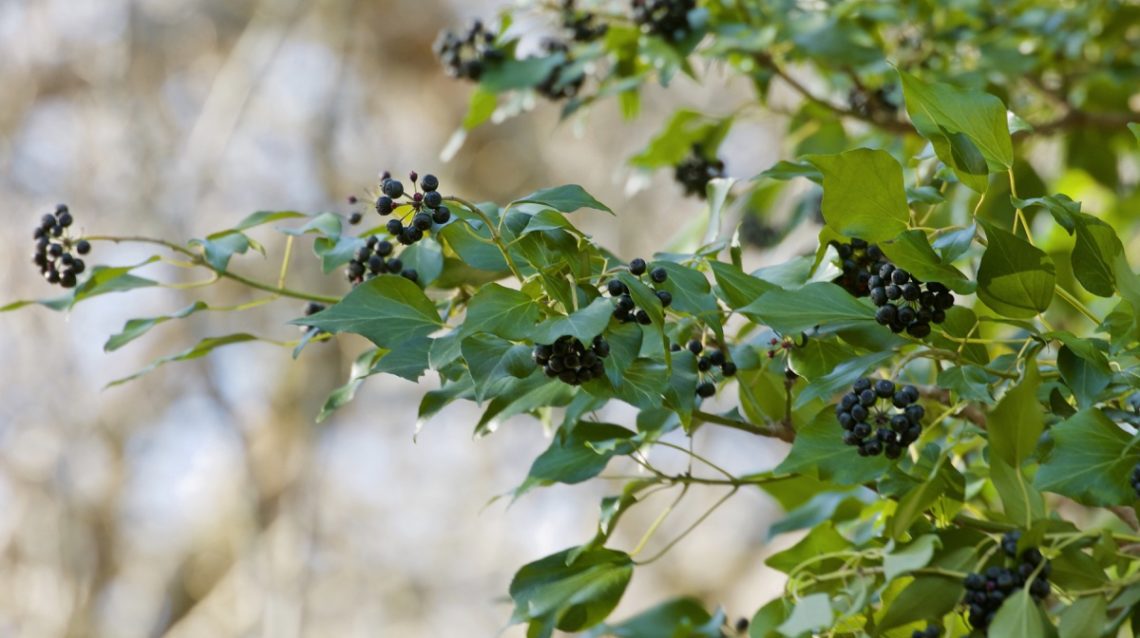
The ivy green
So doth the woodbine the sweet honeysuckle
Gently entwist; the female ivy so
Enrings the barky fingers of the elm.
O how I love thee, how I dote on thee!
Titania, from A Midsummer Night’s Dream, Act IV, Sc I
There’s something particularly attractive about ivy in the dark months of the year, when the autumn leaves have been swept away and there’s very little colour left in the trees. In late November, when the daylight packs its bags at about half-past three in the afternoon, it can feel like the primroses and celandines of spring are at the other end of a long and gloomy tunnel, but there are still some lovely plants to be seen in the woods, and ivy is one of them.
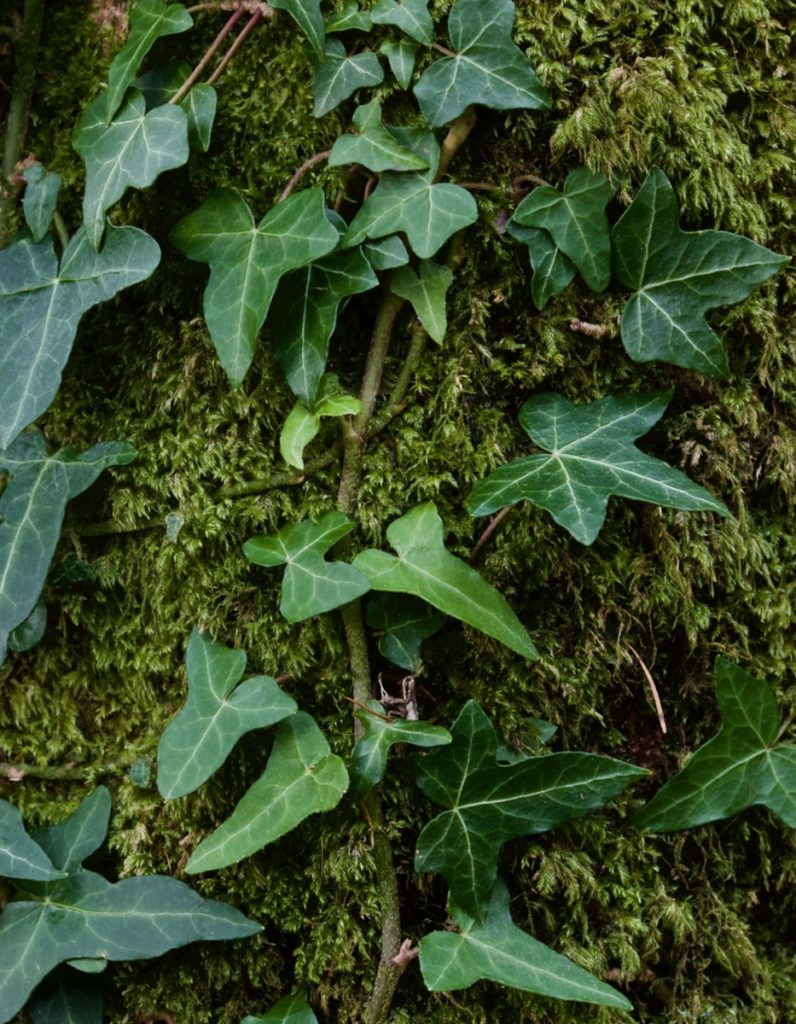
Ivy is a natural climber; the two parts of its Latin name, Hedera helix, roughly translated, mean ‘grasp’ and ‘spiral’ respectively, reflecting its habit of coiling in spirals around a stem or a trunk. But the first shoots of a young ivy plant grow horizontally along the ground and head for the shade, instinctively searching for a vertical support that may be casting a shadow; this behaviour is called negative phototropism. Once they find a suitable tree trunk or wall they start to grow up towards the light, putting out long climbing stems equipped with tiny hairs that help them stick to vertical surfaces.
On mature ivy plants, small yellowish flowers appear in globular clusters from August or September onwards, offering a valuable source of pollen and nectar for all kinds of insects. Once the flowers have been pollinated they ripen into deep purple or black berries which stay on the plant over the winter, attracting hungry thrushes, blackbirds and wood pigeons. In this way, ivy helps to feed a multitude of woodland species, and when it has grown into a sizeable bush it gives cover to roosting birds through the cold winter nights.
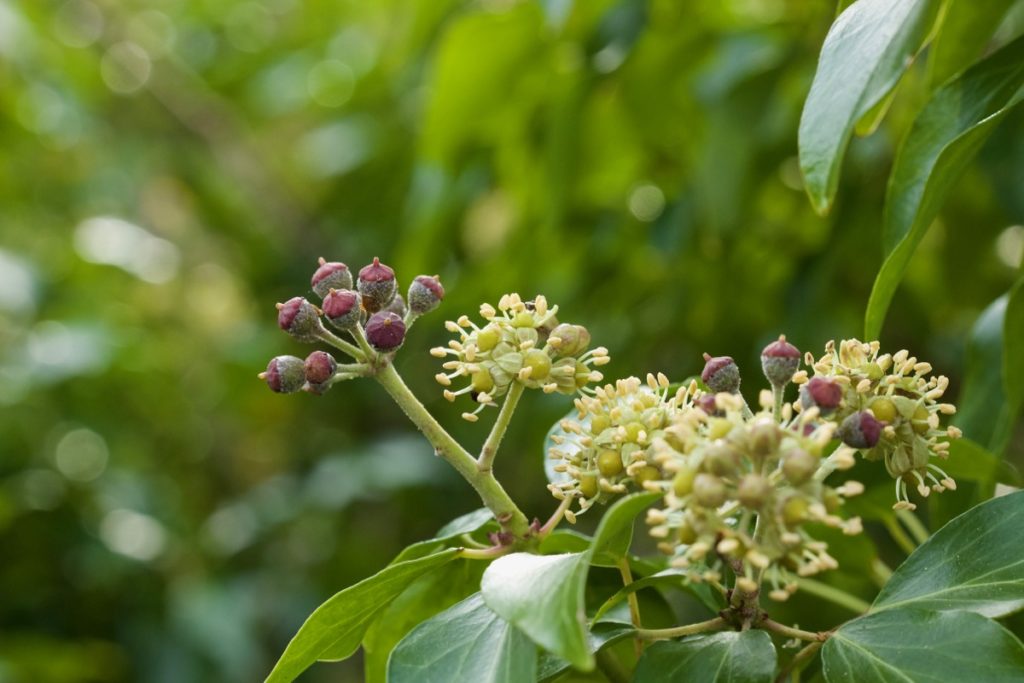
The leaves themselves are beautiful. On a mature specimen they are often large, bright green and glossy, but a younger plant’s leaves are a lovely dark forest green, with distinct lobes that are delicately veined. I love how the long, eagerly-growing stems of ivy can tumble over a wall or a gatepost in a graceful cascade of flowing curves; no wonder they are so popular with flower-arrangers!
The holly and the ivy,
When they are both full-grown,
Of all the trees that are in the wood,
The holly bears the crown.Traditional carol, composed in early 1800s
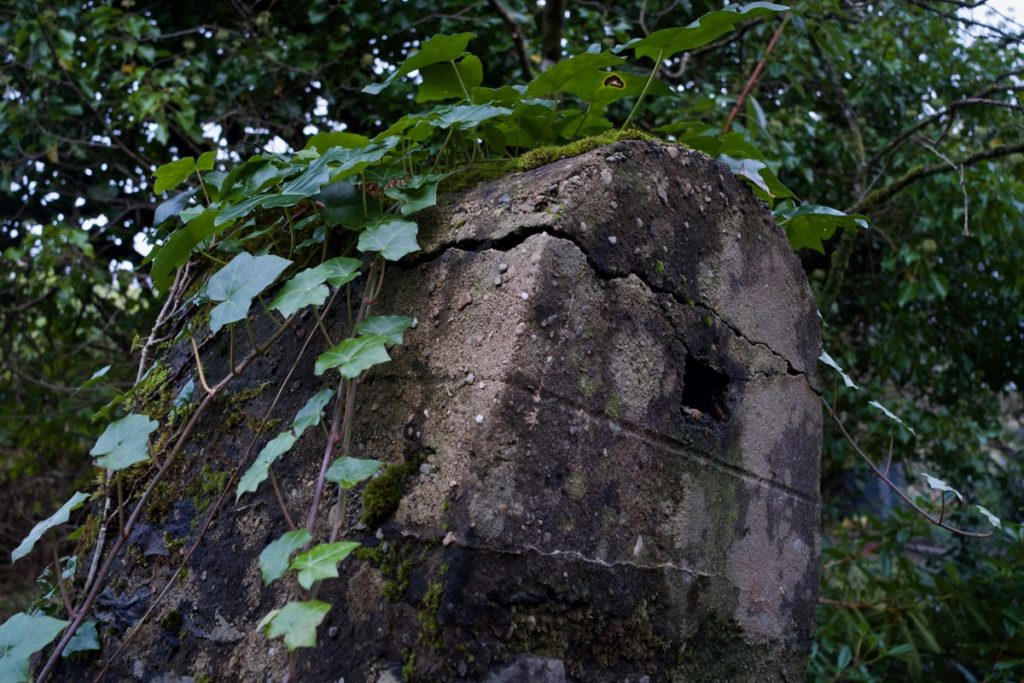
Ivy is often woven into Christmas wreaths, but its significance pre-dates Christianity and is rooted in a time when evergreen species were revered, especially during winter when most trees are bare. Holly is often seen as a ‘masculine’ plant – the holly king was believed to reign until midwinter, when he yielded to the oak king – and ivy is the holly’s ‘feminine’ counterpart. Sprigs of ivy were hung in barns and dairies to keep evil spirits away from cows and their milk (rowan was also used for the same purpose). With a reputation for healing, ivy was often fed to sick cattle, and some Shropshire farmers fed a piece of ivy to all their animals on Christmas morning, in order to keep the Devil away during the coming year.
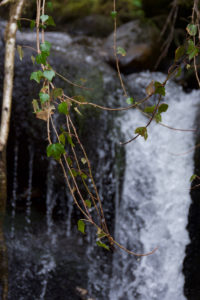 Ivy’s ability to smother grape vines somehow convinced early herbalists that its berries neutralised the effects of alcohol. Wine was drunk from goblets made from ivy wood, or a wreath of ivy leaves was worn around the head in the fond belief that the wearer would stay sober. Ivy-covered poles known as ale-stakes were placed outside taverns, indicating that good wine (and ale and spirits) were available inside. Using this rather distorted logic, ivy became associated with temperance; it also symbolised fidelity, and wreaths of ivy were offered to newly-married couples. Today, some brides still include sprays of ivy in their bouquets.
Ivy’s ability to smother grape vines somehow convinced early herbalists that its berries neutralised the effects of alcohol. Wine was drunk from goblets made from ivy wood, or a wreath of ivy leaves was worn around the head in the fond belief that the wearer would stay sober. Ivy-covered poles known as ale-stakes were placed outside taverns, indicating that good wine (and ale and spirits) were available inside. Using this rather distorted logic, ivy became associated with temperance; it also symbolised fidelity, and wreaths of ivy were offered to newly-married couples. Today, some brides still include sprays of ivy in their bouquets.
In his Flora Britannica (1996), Richard Mabey reports that in the Highlands, garlands of ivy, rowan and honeysuckle were woven as good-luck charms. In the Uists, where trees are scarce, people went to great lengths to collect ivy, even swimming out to an island in a loch. Writing in Plant Lore (1995), Roy Vickery reveals that ivy leaves were once boiled and made into a lotion for treating burns and eczema.
The Victorians loved ivy, and trained it over their summer-houses and bowers, even encouraging it to grow through open windows. On their pilgrimages to ancient buildings, poets and artists admired the sight of ivy-clad walls:
Here, where, of havoc tired and rash undoing,
Man left this Structure to become Time’s prey
A soothing spirit follows in the way
That Nature takes, her counter-work pursuing,
See how her Ivy clasps the sacred Ruin
Fall to prevent or beautify decay…At Furness Abbey, from The Poems of William Wordsworth, 1858
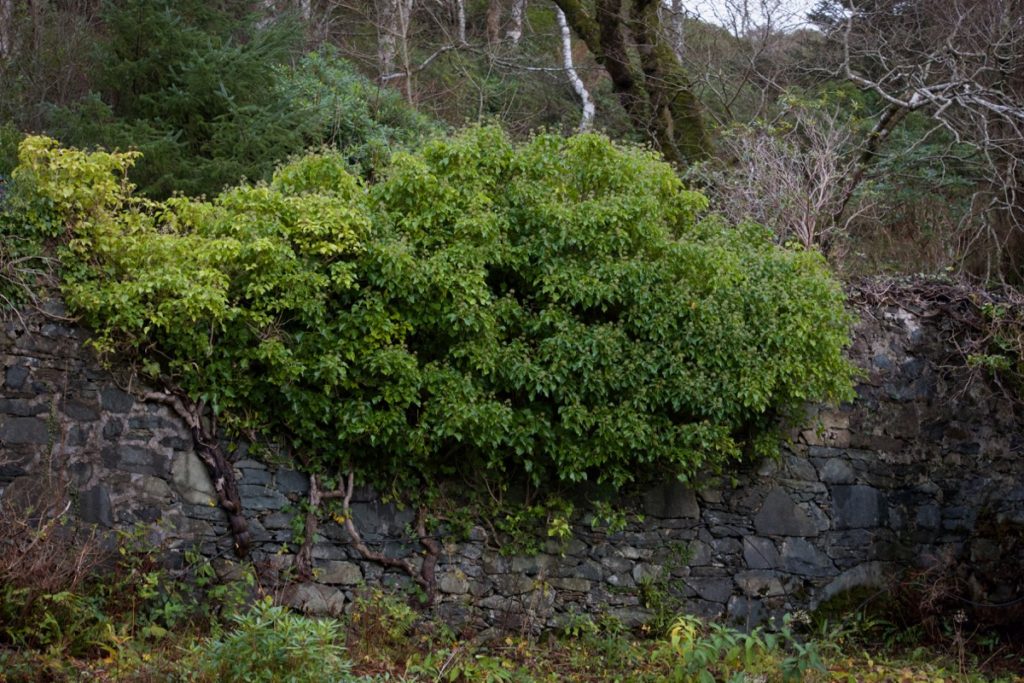
Above: ivy on an old stone wall at Lunga House, and (below) contorted ivy trunk at Old Castle Lachlan
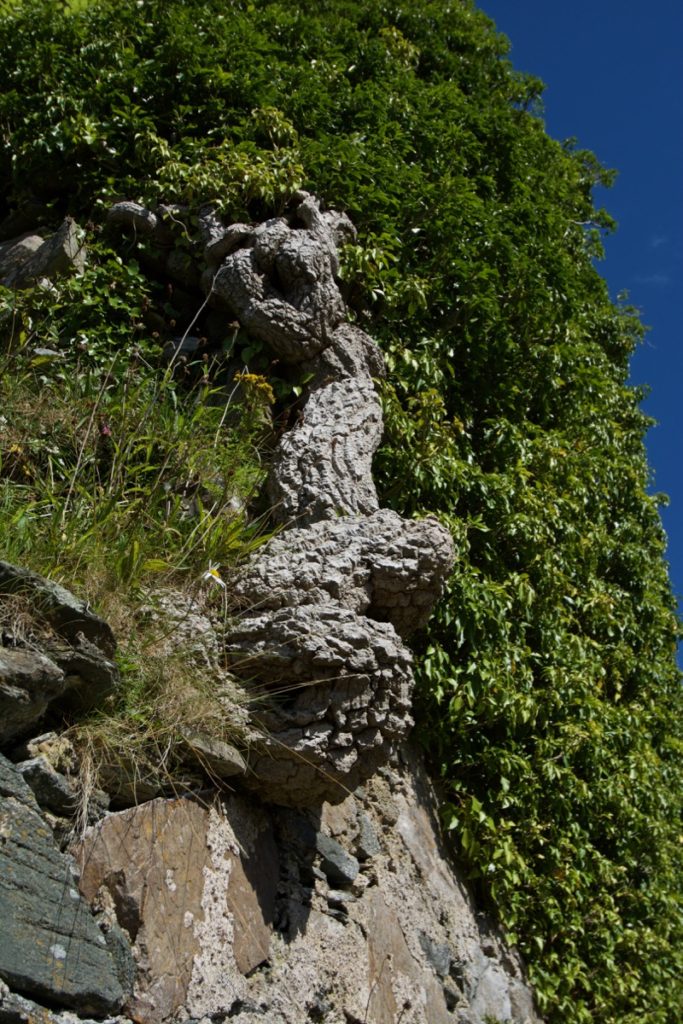
Does ivy really prevent or beautify decay? There’s no denying that it looks picturesque. Research by English Heritage has concluded that, in some cases, ivy will help to preserve old stonework, and the Royal Horticultural Society says that ivy can keep buildings cooler in summer and less damp in winter (I’m guessing that is mostly relevant for places that are still inhabited!) An added bonus is that ivy, growing on or near a house, is said to protect the occupants from witchcraft.
There is an old but mistaken belief that ivy is a parasitic plant, and will kill the trees that it is growing on. In fact, ivy is self-supporting, obtaining nutrients from its own roots and leaves. The trouble comes when it reaches the top of a tree and bushes out, stealing sunlight from the tree’s own leaves and making it unstable from the extra weight.
Fast he stealeth on, though he wears no wings,
And a staunch old heart has he.
How closely he twineth, how tight he clings,
To his friend the huge Oak Tree!Charles Dickens, The Ivy Green, from Pickwick Papers, 1837
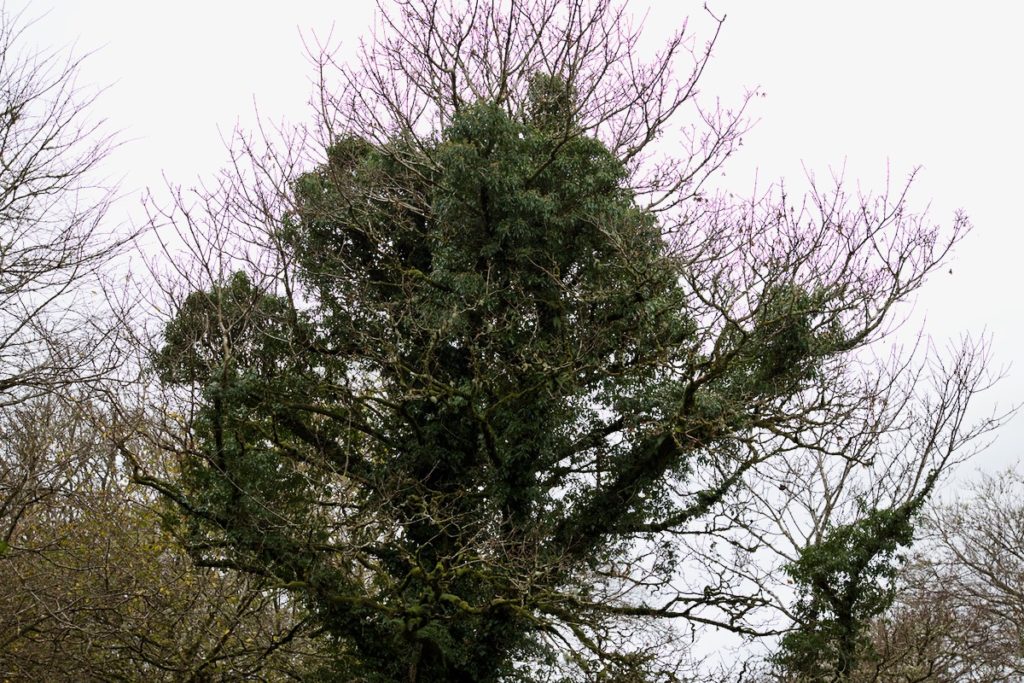
Ivy in a sycamore tree
In her book, The Encyclopedia of Superstitions (1948), Christina Hole describes some curious old practices involving ivy. If a leaf that had been put into a basin of water on New Year’s Eve was still found to be green and fresh on the evening before Twelfth Night, it was a good sign for the coming year; but if black spots had developed, all kinds of troubles could be expected! Young women would place an ivy leaf in their pocket or their bodice, believing that the first man they met would be their future husband, or else leaves were thrown in pairs into the fire, representing potential love-matches. If the leaves jumped together in the flames, the couple would marry; but if they fell apart, so would the relationship.
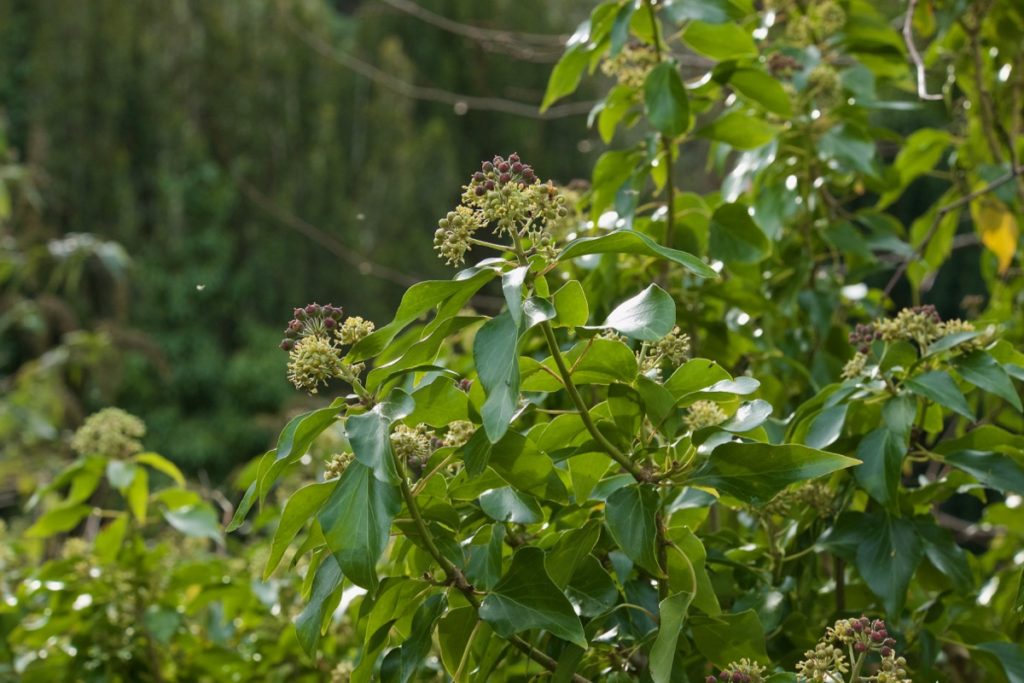
At the time of writing, there are still the remains of flowers to be seen on an ivy-covered wall just up the road, and they had attracted a cloud of little flies in the sunshine yesterday afternoon. Such luxuriant ivy plants must be a haven for insects, and a valuable lifeline for birds that feed on them – wrens, nuthatches, treecreepers – all of which we see and hear regularly. On grey, drizzly days when we need the lights on indoors, we’ll still go and take a walk up into the woods to watch and listen… and it won’t be long before the first primroses are coming through.
Reading and reference:
- Richard Mabey, Flora Britannica (1996)
- Roy Vickery, Plant Lore (1995)
- Christina Hole, The Encyclopedia of Superstitions (1948)
- Plantlife
- Royal Horticultural Society
- The Woodland Trust
- Botanical Society of Britain and Ireland
All images copyright © Colin & Jo Woolf



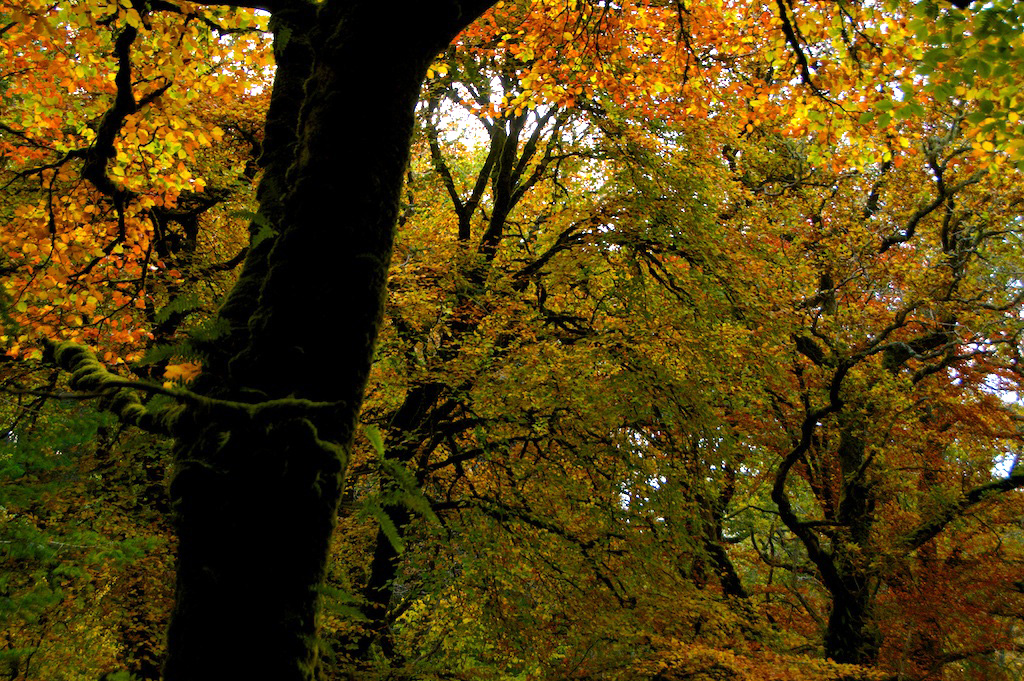
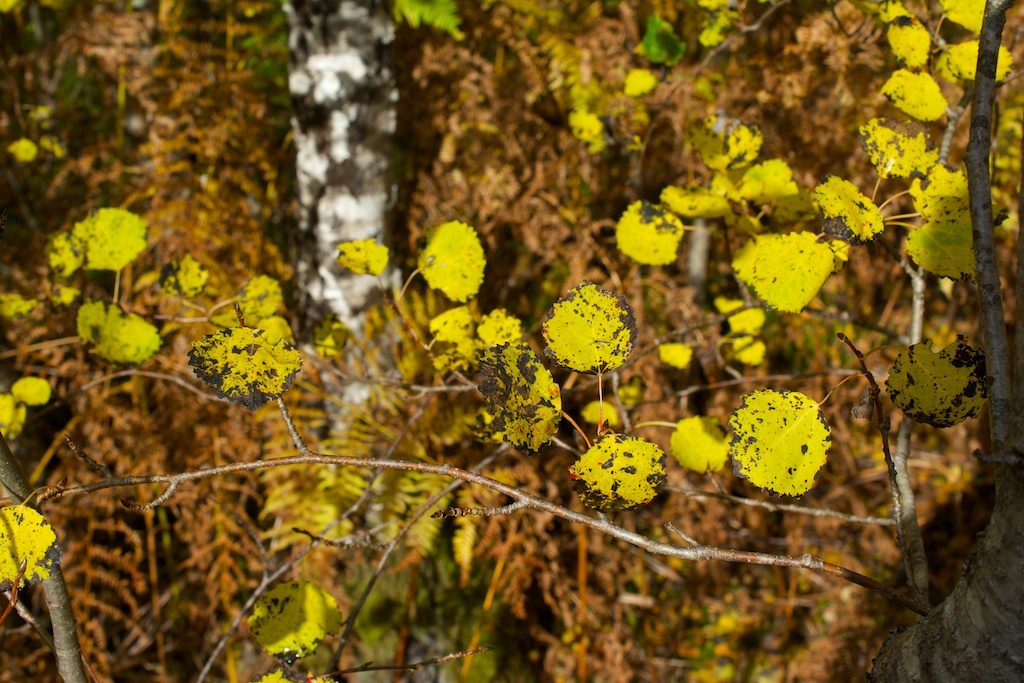
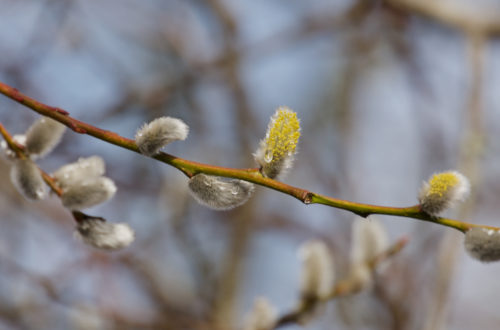
6 Comments
Finola
I love your optimism that spring is just around the corner. I will keep the faith!
I am torn about ivy – I love it as a plant and as such important autumn forage. But it really can damage old buildings.
Jo Woolf
Ah, I know! Every year, it’s the same, when the dark evenings arrive, but in terms of weeks it’s not that long! Like you, I love ivy but I’ve seen places where ivy roots are now the only things holding stones together – it’s such a dilemma.
Richard Miles
I have always liked ivy,having been an arborist for thirty years ,I have realised it rarely affects the health of a tree and as you said it provides a lot of cover for wildlife especially in the winter.Also as a beekeeper my bees are attracted to ivy flowers by their slightly heavy sweet smell at a time of year when flowers in general are scarce.
Jo Woolf
That’s really good to hear, thank you Richard!
Gail
https://bto-enews.org/NXK-83U5Z-1A2B0E1DCE080E38LXD95D20FF0D6F4232E6F1/cr.aspx
This latest BTO newsletter has some interesting info about the proportions of different insects that use the nectar from ivy flowers.
Jo Woolf
Thank you, Gail! Fabulous to see so many species of insect supported by ivy.